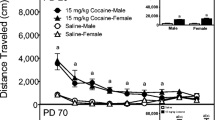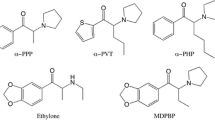Abstract
Three hundred and twenty mouse pups of both sexes of the CD-1 outbred strain received IP muscimol and were subsequently assessed for locomotor activity (single Varimex 30-min session) and for hot-plate responding. Muscimol doses were 0.05, 0.1, or 0.2 mg/kg at 8 and 14 days, and 0.1, 0.5, or 1.0 mg/kg at 21, 28, and 35 days. Activity data showed a shift from an immature pattern at 8 and 14 days to an adult-like pattern from day 21 onwards (high initial activity followed by a marked within-session decrement). Muscimol was ineffective on day 8, and depressed activity from day 14 onwards. At 28 days, however, the higher-dose male group showed a non-monotonic trend of activity; that is, an initial depression followed by a marked rebound hyperactivity. With regard to hot-plate exposure, muscimol was ineffective at 8 days, while it produced maximal analgesic effects on day 14, followed by a progressive decrease in drug sensitivity. Around day 70, mice of the former 0.1 mg/kg and saline groups were re-tested for locomotor activity and pain reactivity without additional drug treatment. Activity was generally higher in males than in females, and two groups habituated significantly less than the others (females tested in the muscimol state at 8 days and males tested in the saline state at 35 days). Moreover, prior testing at the earliest ages and prior muscimol exposure had additive attenuating effects on pain reactivity. These developmental profiles indicate that GABAergic systems contribute to the modulation of pain reactivity by mechanisms which are at least in part separate from those involved in the depression of activity. Developmental changes in3H-muscimol and its metabolite disposition in brain were also assessed.
Similar content being viewed by others
References
Alleva E, Bignami G (1985) Development of mouse activity, stimulus reactivity, habituation and response, to amphetamine and, scopolamine. Physiol Behav 34:519–523
Alleva E, Bignami G (1986) Prenatal benzodiazepine effects in mice: postnatal behavioral development, response to drug challenges, and adult discrimination learning. Neurotoxicology 7:309–323
Alleva E, Laviola G (1987) Short-term and delayed behavioral effects of pre- and post-weaning morphine in mice. Pharmacol Biochem Behav 26:539–542
Alleva E, Laviola G, Tirelli E, Bignami G (1985) Short-, medium-, and long-term effects of prenatal oxazepam on neurobehavioural development of mice. Psychopharmacology 87:434–441
Alleva E, Laviola G, Bignami G (1987) Morphine effects on activity and pain reactivity of developing mice with or without late prenatal oxazepam exposure. Psychopharmacology 92:438–440
Baraldi M, Grandison L, Guidotti A (1979) Distribution and metabolism of muscimol in the brain and other tissues of the rat. Neuropharmacology 18:57–62
Bartholini G (1980) Interaction of striatal dopaminergic, cholinergic and GABA-ergic neurons: relation to extrapyramidal function. TIPS January: 138–140
Bateson P (1986) When to experiment on animals. New Scientist 1496:30–32
Camp LL, Rudy JW (1988) Changes in the categorization of appetitive and aversive events during postnatal development of the rat. Dev Psychobiol 21:25–42
Campbell BA, Mabry PD (1972) Ontogeny of behavioral arousal: A comparative study. J Comp Physiol Psychol 81:371–379
Campbell BA, Raskin LA (1978) Ontogeny of behavioral arousal: The role of environmental stimuli. J Comp Physiol Psychol 92:176–184
Caza PA, Spear LP (1980) Ontogenesis of morphine-induced behavior in the rat. Pharmacol Biochem Behav 13:45–50
Chiarotti F, Alleva E, Bignami G (1987) Problems of test choice and data analysis in behavioral teratology: The case of prenatal benzodiazepines. Neurotoxicol Teratol 19:179–186
Christensen AV, Larsen JJ (1982) Antinociceptive and anticonvulsant effect of THIP, a pure GABA agonist. Pol J Pharmacol Pharm 34:127–134
Christensen AV, Arnt J, Scheel-Krüger J (1978) Muscimol antagonizes morphine hypermotility without potentiation of analgesia. Eur J Pharmacol 48:459–462
Coyle JT, Enna SJ (1976) Neurochemical aspects of the ontogenesis of GABAergic neurons in the rat brain. Brain Res 111:119–133
Denenberg VH (1984) Some statistical and experimental considerations in the use of analysis-of-variance procedure. Am J Physiol 246:R403-R408
Ferkany JW, Enna SJ (1980) Interaction between GABA agonists and the cholinergic muscarinic system in rat corpus striatum. Life Sci 27:143–149
Gale KN, Costa E, Toffano G, Hong JS, Guidotti A (1978) Evidence for a role of nigral GABA and substance P in in the haloperidol induced activation of striatal tyrosine hydroxylase. J Pharmacol Exp Ther 206:29–37
Hamm RJ, Knisely JS (1987) Developmental differences in the analgesia produced by the central cholinergic system. Dev Psychobiol 20:345–354
Hammond DL, Drower EJ (1984) Effects of intrathecally administered THIP, baclofen and muscimol on nociceptive threshold. Eur J Pharmacol 103:121–125
Herberg LJ, Williams SF (1983) Anti-conflict and depressant effects by GABA agonists and antagonists, benzodiazepines and non-GABAergic anticonvulsants on self-stimulation and locomotor activity. Pharmacol Biochem Behav 19:625–633
Huntingford FA (1984) Some ethical issues raised by studies of predation and aggression. Anim Behav 32:210–215
Jondorf WR, Maickel RP, Brodie BB (1959) Inhability of newborn mice and guinea pigs to metabolize drugs. Biochem Pharmacol 1:352–354
Kaught JL, Pelley K, Costa LG, Setler P, Enna SJ (1985) A comparison of the antinociceptive responses to the GABA-receptor agonists THIP and baclofen. Neuropharmacology 24:211–216
Kehoe P, Blass EM (1986) Behaviorally functional opioid system in infant rats: II. Evidence for pharmacological, physiological, and psychological mediation of pain and stress. Behav Neurosci 100:624–630
Kendall DA, Browner M, Enna SJ (1982) Comparison of the antinociceptive effect of γ-aminobutyric acid (GABA) agonists: Evidence for a cholinergic involvement. J Pharmacol Exp Ther 220:482–487
Kimmel CA, Buelke-Sam J, Adams J (1985) Collaborative behavioral teratology study: implications, current applications and future directions. Neurobehav Toxicol Teratol 7:669–673
Knisely JS, Hamm RJ (1986) Environmentally induced analgesia: Ontogeny of a nonopioid system. Dev Psychobiol 19:27–36
Kontro P, Marnela KM, Oja SS (1984) GABA, taurine and hypotaurine in developing mouse brain. Acta Physiol Scand [Suppl] 537:71–74
Laviola G, Renna G, Bignami G, Cuomo V (1988) Ontogenetic and pharmacological dissociation of various components of locomotor activity and habituation in the rat. Int J Dev Neurosci 6:431–438
Maggi A, Enna SJ (1979) Characteristics of muscimol accumulation in mouse brain after systemic administration. Neuropharmacology 18:361–366
Morselli PL (1977) Drug disposition during development. Spectrum, New York
Murphy JM, Meeker RB, Porada KJ, Nagy ZM (1979) GABA-mediated behavioral inhibition during ontogeny in the mouse. Psychopharmacology 64:237–242
Nagy ZM, Murphy JM, Ray D (1975) Development of behavioral arousal and inhibition in the Swiss-Webster mouse. Bull Psychon Soc 7:285–288
Olsen RW, Craig-Venter J (1986) Benzodiazepine/GABA receptors and chloride channels: structural and functional properties. Liss, New York
Randall PK, Campbell BA (1976) Ontogeny of behavioral arousal in rats: effects of maternal and sibling presence. J Comp Physiol Psychol 90:453–459
Sawinok J (1987) GABAergic mechanisms of analgesia: an update. Pharmacol Biochem Behav 26:463–474
Scatton B, Bartholini G (1980) Modulation by GABA of cholinergic transmission in the striatum. Brain Res 183:211–216
Scheel-Krüger J (1984) GABA in the striatonigral and striatopallidal systems as moderator and mediator of striatal functions. Adv Neurol 40:85–90
Scheel-Krüger J, Christensen AV, Arnt J (1978) Muscimol differentially facilitates stereotypy but antagonizes motility induced by dopaminergic drugs: a complex GABA-dopamine interaction. Life Sci 22:75–84
Shah NS, Hanlin J, Eargle D, Yates J (1980) Effect of gamma-amino-butyric acid (GABA) and baclophen on the methyl-phenidate-induced behavior in rats during ontogenesis. Brain Res Bull 5:525–529
Sidel ES, Tilson HA, McLamb RL, Wilson WA, Swartzwelder HS (1988) Potential interactions between GABAb and cholinergic systems: baclofen augments scopolamine-induced performance deficits in the eight-arm radial maze. Psychopharmacology 96:116–120
Spear LP, Penson J, Linville DG (1986) GABA and behavioral inhibition in the neonatal rat pup. Psychopharmacology 90:106–111
Tirelli E (1987) Ontogeny of GABA-ergic and dopaminergic mediation of gnawing behavior in the mouse. Psychopharmacology 92:89–95
Tirelli E (1989a) The GABA-A agonist muscimol facilitates muscular twitches and locomotor movements in the newborn mouse. Pharmacol Biochem Behav 33:497–500
Tirelli E (1989b) Functional maturation of the GABAergic inhibition on dopamine-mediated behaviours during the neonatal period in the mouse. Behav Brain Res 33:83–95
Wilcox RR (1987) New statistical procedures for the social sciences. Modern solutions to basic problems. Lawrence Erlbaum, Hillsdale, New Jersey
Wood PL (1982) Actions of GABAergic agents on dopamine metabolism in the nigrostriatal pathway of the rat. J Pharmacol Exp Ther 222:674–679
Author information
Authors and Affiliations
Additional information
Part of the data reported here was presented at the “1st Convegno Nazionale dei Giovani Cultori di Neuroscienze” Rome, 11–12 December 1987
Rights and permissions
About this article
Cite this article
Laviola, G., Alleva, E. Ontogeny of muscimol effects on locomotor activity, habituation, and pain reactivity in mice. Psychopharmacology 102, 41–48 (1990). https://doi.org/10.1007/BF02245742
Received:
Revised:
Issue Date:
DOI: https://doi.org/10.1007/BF02245742




